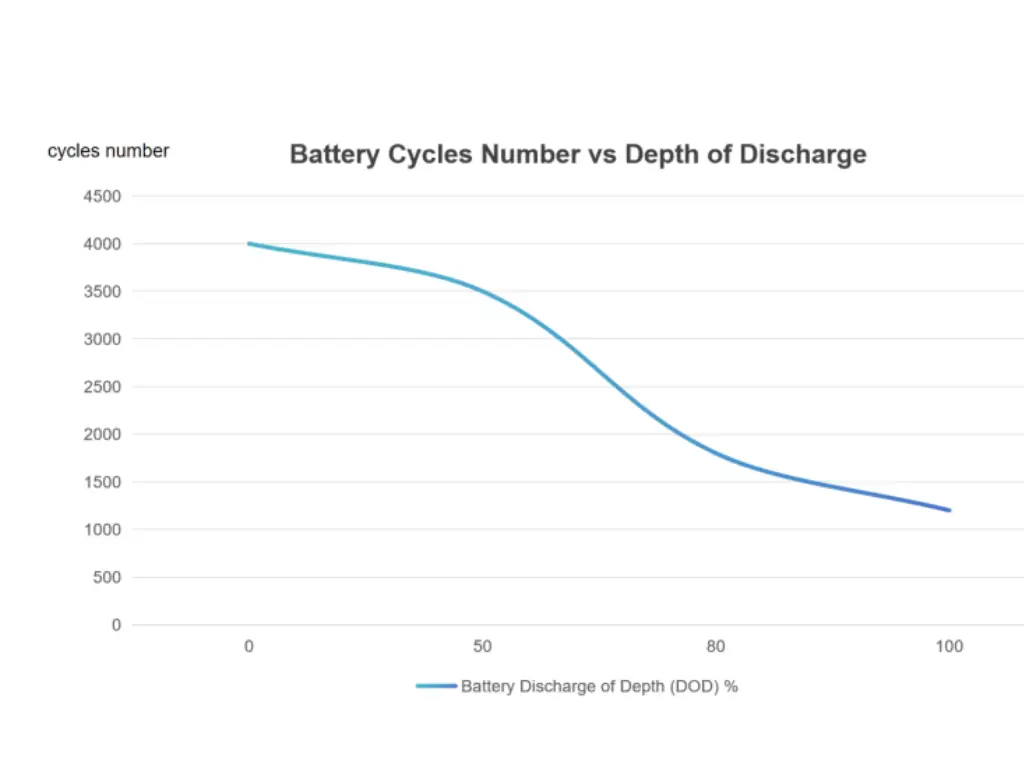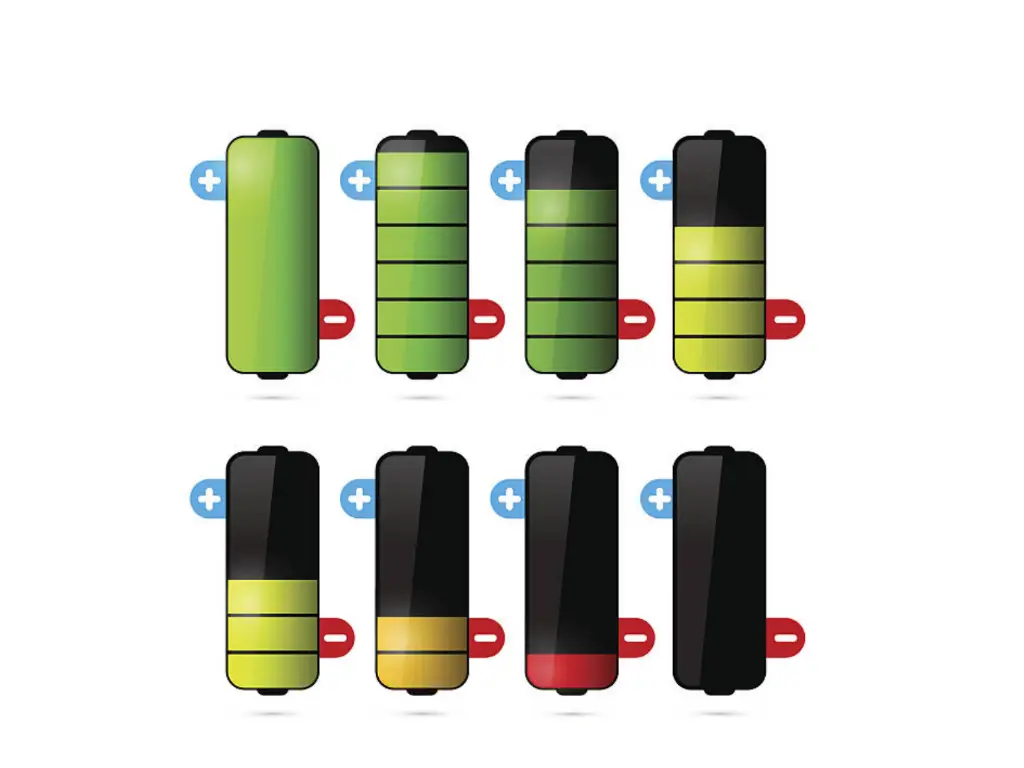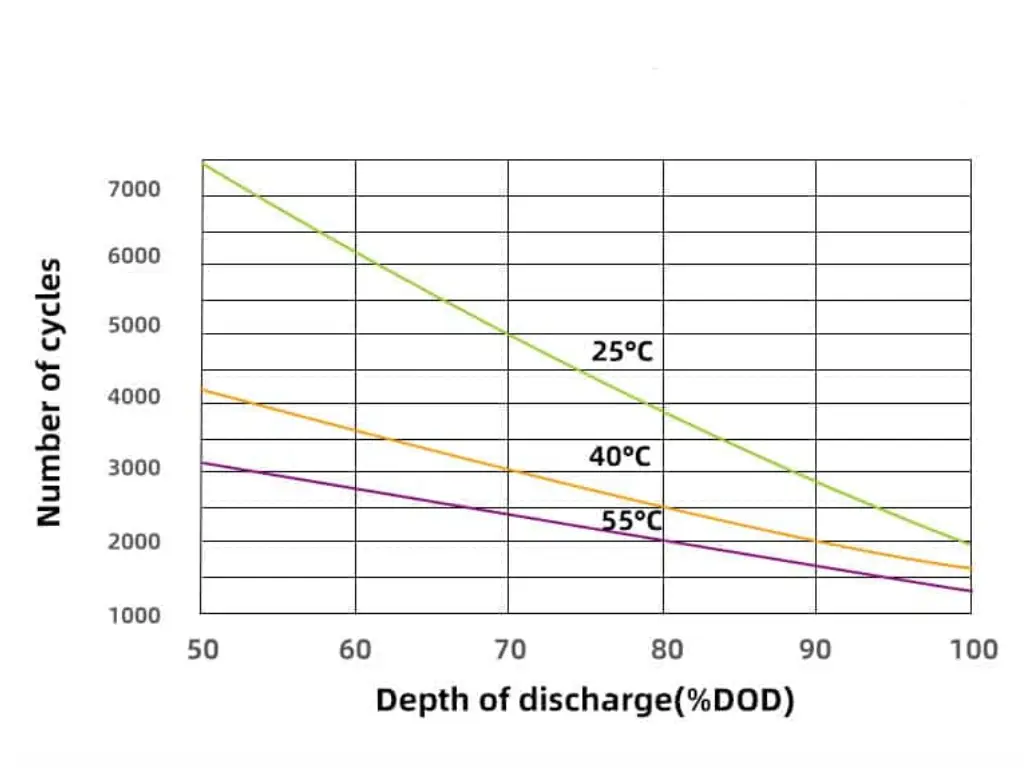In the domain of large-scale battery applications, understanding life of the battery and performance dynamics of your investment is imperative. The Electric Power Research Institute’s research highlights that suboptimal battery management, especially concerning the depth of discharge (DoD), can significantly reduce the anticipated lifespan of a battery, affecting its useful life by as much as 50%. This is crucial for clients dependent on robust battery infrastructures, such as those using solar panels, where efficiency and endurance are paramount. Depth of Discharge, or battery DoD, is more than technical jargon; it fundamentally influences the efficacy and financial yield of your battery investment. We’ll explore the DoD’s impact on battery longevity and operational performance, helping you optimize your battery systems for maximum DoD and overall capacity of the battery.
What is Depth of Discharge in the Battery?
What, then, constitutes the Depth of Discharge (DoD) in the realm of battery technology?
Battery Depth of Discharge, frequently abbreviated as DoD, is a technical metric that quantifies the extent to which a battery’s stored energy has been expended. To envision this concept, picture a fully charged battery as analogous to a reservoir brimming with water. With each utilization of the battery, a proportion of this ‘water’—or, more accurately, stored electrical energy—is depleted. The Depth of Discharge provides a metric, denoting the percentage of energy that has been drained from the battery. A higher DoD percentage indicates a more substantial depletion of the battery’s total capacity.
In practical terms, understanding DoD is not merely about recognizing how much energy has been used; it also involves comprehending the implications of these usage levels on the battery’s overall health and efficiency. Different batteries have varying tolerances for DoD, with some capable of enduring deep discharges while others may suffer in terms of longevity and performance. Therefore, a nuanced appreciation of DoD is crucial for effective battery management and optimization.
Related Post: The Essential Guide to Battery Reserve Capacity: What You Need to Know
Why is Depth of Discharge So Important?
The Depth of Discharge (DoD) plays a pivotal role in the realm of battery technology, critically influencing a battery’s longevity, operational performance, and overall efficiency. When a battery undergoes a high DoD, implying that it is frequently discharged to a significant extent of its capacity, there is an attendant reduction in its overall life span. This phenomenon occurs because deeper discharge cycles impose greater stress on the battery, thus accelerating the rate of wear and tear.

To illustrate, consider a battery that is routinely discharged to 80% of its total capacity. Statistically, this battery is likely to exhibit a reduced lifespan compared to a battery that is consistently discharged only to 50% of its capacity. This scenario can be analogized to the physical exertion experienced in running full marathons as opposed to shorter races; the more intensive and prolonged the usage, the greater the stress on the ‘athlete,’ in this case, the battery, resulting in a negative impact on its lifespan.
Effective understanding and management of DoD are indispensable for maintaining battery health. By judiciously monitoring and controlling the DoD, one can optimize the battery’s performance and significantly extend useful life of the battery. This aspect is particularly vital in scenarios where battery dependability and durability are of paramount importance, such as in renewable energy installations or electric vehicle applications. Proper stewardship of DoD ensures that the battery operates at peak efficiency throughout its lifecycle, delivering consistent power and reducing the frequency of replacements, thereby offering both economic and environmental benefits.
Depth of Discharge vs. State of Charge vs. Battery Capacity
Now, you might be thinking, “Isn’t that the same as battery state of charge (SoC)?” Not quite!

When we conceptualize a battery as an energy storage vessel, akin to a tank with a 100-liter capacity, we are referring to its Battery Capacity – the maximal quantum of energy it is engineered to hold. Suppose you draw 40 liters from this reservoir. In this context, the DoD is 40%, indicating that you have expended 40% of the battery’s total energy reserve. Conversely, the SoC stands at 60%, representing the remaining 60 liters or 60% of energy still retained in the storage system.
Within this framework, the battery’s capacity (illustrated as 100 liters) is the pinnacle of energy storage capacity of the battery. The DoD (40 liters utilized) quantifies the fraction of the battery’s energy that has been expended, while the SoC (60 liters remaining) signifies the proportion of energy that is yet available for use. Grasping these three critical aspects is of paramount importance for maintaining battery health and maximizing efficiency, particularly for professionals tasked with the management of large-scale battery systems or intricate energy infrastructures. This intricate understanding aids in making well-informed decisions regarding battery utilization, maintenance, and comprehensive energy management strategies.
Types of Batteries and Their Depth of Discharge
Different strokes for different folks, right? The same goes for batteries. Each type has its own DoD sweet spot.
Lithium-Ion Batteries and Their DoD Capabilities
Lithium-ion batteries, a cornerstone in contemporary battery technology, are distinguished by their remarkable Depth of Discharge (DoD) capabilities. Characteristically, these batteries can efficaciously utilize upwards of 80% of their total energy capacity while maintaining minimal degradation in performance. To contextualize, consider a lithium-ion battery with a capacity of 100 amp-hours; it can be discharged down to a residual 20 amp-hours, thereby harnessing 80 amp-hours of energy for deep cycle battery applications such as in RVs, golf carts, and fishing boats.
This elevated DoD threshold stands as a significant merit, particularly in fields where efficiency and weight considerations are paramount, such as in the manufacturing of electric vehicles and the production of smartphones. The capacity to exploit a substantial portion of the battery’s energy reserve without adversely affecting its lifespan or operational efficiency renders lithium-ion technology exceptionally advantageous. These batteries can also operate at higher voltages, which makes them suitable for applications requiring high power output. It is this synthesis of high energy density coupled with a robust DoD capacity that elevates lithium-ion batteries as a preferred option across a spectrum of applications, ranging from consumer electronics to large-scale energy storage systems. Proper comprehension and utilization of their DoD capabilities are crucial in optimizing their performance and extending their service life.
Lead Acid Batteries and DoD
Old but gold, lead acid batteries prefer a gentler approach. A DoD of 50% is ideal for these workhorses. They’re heavier and less efficient than lithium-ion but are cost-effective for stationary applications like backup power systems.
AGM Batteries and DoD
AGM (Absorbent Glass Mat) batteries are a type of lead acid battery but with a twist. They can handle slightly higher DoDs, around 60%, and are more resistant to vibration and shock. They’re great for RVs and boats.
Gel Batteries and DoD
Gel batteries are the Zen masters in the lead-acid family. With a similar DoD range to AGM batteries, they’re super tolerant of extreme temperatures and deep discharging, and they can sustain minimum voltage levels even under deep discharge conditions.. They’re often found in off-grid solar systems.
Upon conducting a thorough examination of the distinct properties inherent to various battery categories, it becomes unmistakably clear that each category exhibits unique Depth of Discharge (DoD) attributes and possesses its own set of operational intricacies. In order to elucidate the nuances and delineate the contrasts more effectively among these diverse battery types, an analytical overview is presented here in the form of a detailed comparative table.
| Battery Type | Recommended Max DoD | Average Lifespan (Cycles) | Weight | Cost | Suitable Applications |
| Lithium-Ion | 80% | 1,200-1,500 | Light | High | RVs, Golf Cart, Marine Boats, Electric Vehicles, Portable Electronics |
| Lead Acid | 50% | 500-800 | Heavy | Low | Backup Power Systems |
| AGM | 60% | 600-900 | Medium | Medium | RVs, Boats |
| Gel | 60% | 700-1,000 | Medium | Medium | Off-Grid Solar Systems |
You May Like: Gel vs Lithium Battery Showdown: Which Comes Out on Top?
The Role of Depth of Discharge in Battery Lifespan
In the domain of battery technology, the Depth of Discharge (DoD) is one of important factor in determining a battery’s overall lifespan. Specifically, a battery subjected to regular deep discharges, for instance, to 80% of its capacity (equating to an 80% DoD), is likely to experience a reduced lifespan in comparison to a battery typically discharged to merely 50% of its capacity. For instance, a lithium batteries regularly discharged to only 50% might last for 3,000 to 4,000 cycles, whereas the same battery consistently discharged to 80% could see its cycle life reduced to 1600-2000 cycles.
The underlying rationale is that each cycle of discharge followed by recharge exerts wear on the battery’s internal mechanisms. A more profound discharge level imposes heightened strain on these components, thereby accelerating the degradation process. Consequently, by maintaining a lower average DoD, the stress inflicted upon the battery is effectively mitigated, which in turn contributes to an extended battery life.

It is imperative to acknowledge that the longevity of a battery is contingent on a spectrum of factors, extending well beyond the mere parameter of Depth of Discharge (DoD). Intriguingly, even when maintaining a constant DoD, the operational lifespan of a battery, quantified in terms of its charge-discharge cycles, exhibits variability under disparate thermal conditions. Predominantly, elevated operational temperatures tend to precipitate a diminution in the aggregate number of cycles. This phenomenon is attributable to the fact that higher battery temperatures expedite the internal chemical reactions within the battery’s electrochemical cells, thereby inducing a more rapid rate of capacity decay and consequently truncating the battery’s operational lifespan.
How to Monitor and Measure DoD?
Accurately monitoring and measuring battery’s depth of discharge and discharge rate constitutes a vital element in the realm of sophisticated battery management, playing a pivotal role in keeping battery optimal performance and battery lifetime. The calculation of DoD is achieved by assessing the amount of charge a battery has used in relation to its nominal capacity and discharge rate. To elucidate, a battery with a total capacity of 100 amp-hours, when depleted by 40 amp-hours during usage, results in a calculated DoD of 40%.
In contemporary battery management systems, the integration of advanced software solutions is a prevalent approach for monitoring DoD. These state-of-the-art systems engage in detailed tracking of the battery’s energy output, providing real-time insights into the DoD. This enables a nuanced understanding of the battery’s usage patterns and energy expenditure.
For batteries lacking in-built advanced monitoring capabilities, the deployment of external monitoring tools like battery monitors and charge controllers offers an effective alternative. These external devices, proficient in measuring parameters such as battery voltage and current, are instrumental in delivering precise DoD calculations.
Conclusion and Future Outlook
As battery storage solutions become more integrated with renewable energy sources, optimizing DoD will play a crucial role in the efficient management of these systems. As we move towards more sustainable energy solutions, getting the most out of our batteries not only makes economic sense but is also a step towards a greener future.





8 thoughts on “What is Depth of Discharge? Everything You Need to Know”
This begs the question, why use lithium ion when Musk could have chosen Lithium Iron Phosphate (LiFePo4)? They can last up to 10,000 cycles, they only take up 15 more space, and they don’t have thermal runaway characteristics (don’t explode and catch fire). They are also WAY WAY WAY more environmentally friendly.
The real argument against nuclear is that we are running out of fuel. Yes, uranium is non-renewable, and the kind needed by the installed reactors (almost all of them) is hard to get indeed. One day breeder reactors will solve this, but today is not this day.
There’s been some really exciting news in batteries over the last year. One recent thing I was reading was about how an additive for lowering the combustibility of Lithium batteries made higher density possible and may let sodium be used in lithium’s stead. Trouble is, I got my optimism damaged by all the “imminent breakthrough in batteries, 10x the capacity!!!!1111” articles through the 80s, 90s which turned out to be marginal progress if any. So I’m not sure if much of the recent stuff is “real world” tech we’re gonna see soon or not. ( I still thought I was gonna have a wall sized OLED TV for a couple of hundred by 2010. )
Information mansion in the blog helps me determine the best suitable and affordable battery to use. Great blog, keep posting.
What do you think is best for your needs?
Hi Andy thanks for the blog some great information here I have a portable power generator that uses lithium iron phosphate Battery Technology. Would you recommend to use the same charging habits for those devices? such as use until discharge rate of 15-20 then charge until 95. And for long-term periods of not used to charge until around 50. I bought the device in case of an emergency or that I need to shut the main power down such as approaching thunderstorms to give me power. mainly just for my refrigerator. i’ve been using it daily by charging it with solar power from the mains in the daytime. then using it in the evening to run a few of my devices. so I’m saving some energy on the electric bill and also I’m using the device. my solar system is on grid so it works only in daytime and i have no batteries which are hardwired into the electrical system of the house. Overall I’m happy with my purchase but I read in a forum that the battery percentage state of charge display on these types of devices on the lcd is not always completely accurate. I appreciate any comments or insights you can provide about this topic. thank you
i agree that the newest (and future) nuclear technologies are “the way” for bulk power,but; “when seconds count”… nuclear “is just minutes away”…then-again, with the newest nuclear technologies, maybe we can design a second “emergency shutdown” mode(s) to cope with excess power, along with the existing obligatory load-shedding to deal with lack of power. but people around here expect a certain reliability from the electric supply.personally, i always like to remember that a dam-as-a-storage can actually be constructed underground instead, by turning a river into a waterfall into an underground tank, then pumping it out to takeup excess energy. as confusing as that may be for the average joe, storing energy by getting rid of something sounds backwards.
“May you have an interesting life.” Old Chinese curse. Our future is gonna be super interesting as we transition to renewable power and EVs. I can imagine a household with 2 EVs, one of them charging during the day from solar panels. Then the other EV comes home, having gotten a charge at work or the mall, and sucks a little juice from EV #1. And maybe the grid goes down and the 2 EVs run the house. Wish I had 20 or 30 more years to see all the neat stuff coming.